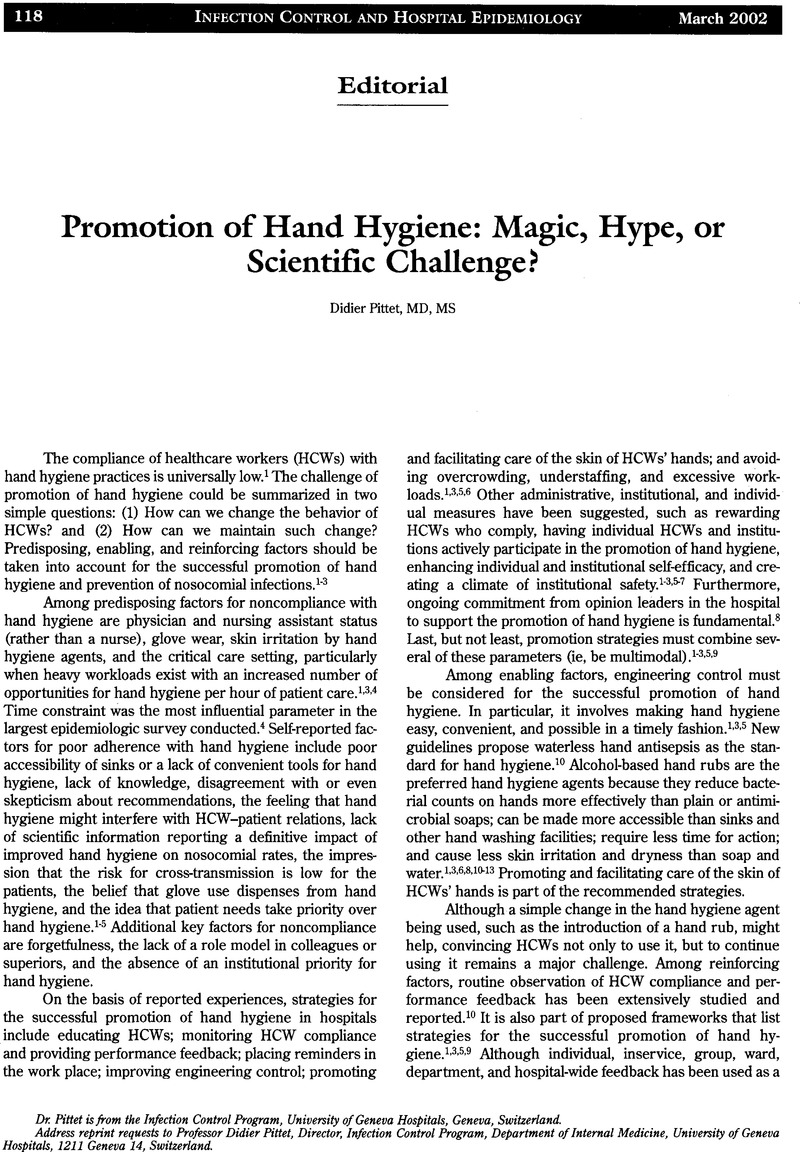Crossref Citations
This article has been cited by the following publications. This list is generated based on data provided by Crossref.
Bissett, Linda
2002.
Can alcohol hand rubs increase compliance with hand hygiene?.
British Journal of Nursing,
Vol. 11,
Issue. 16,
p.
1072.
Francois, Patrice
Pittet, Didier
Bento, Manuela
Pepey, Béatrice
Vaudaux, Pierre
Lew, Daniel
and
Schrenzel, Jacques
2003.
Rapid Detection of Methicillin-Resistant
Staphylococcus aureus
Directly from Sterile or Nonsterile Clinical Samples by a New Molecular Assay
.
Journal of Clinical Microbiology,
Vol. 41,
Issue. 1,
p.
254.
Lankford, Mary G.
Zembower, Teresa R.
Trick, William E.
Hacek, Donna M.
Noskin, Gary A.
and
Peterson, Lance R.
2003.
Influence of Role Models and Hospital Design on the Hand Hygiene of Health-Care Workers.
Emerging Infectious Diseases,
Vol. 9,
Issue. 2,
p.
217.
2004.
Recommended Practices For Surgical Hand Antisepsis/Hand Scrubs.
AORN Journal,
Vol. 79,
Issue. 2,
p.
416.
Clark, Reese
Powers, Richard
White, Robert
Bloom, Barry
Sanchez, Pablo
and
Benjamin, Daniel K
2004.
Prevention and Treatment of Nosocomial Sepsis in the NICU.
Journal of Perinatology,
Vol. 24,
Issue. 7,
p.
446.
Marshall, Caroline
Kossmann, Thomas
Wesselingh, Steve
and
Spelman, Denis
2004.
Methicillin‐resistant Staphylococcus aureus and beyond: what's new in the world of the ‘golden staph’?.
ANZ Journal of Surgery,
Vol. 74,
Issue. 6,
p.
465.
Knauer, Ariane
Fladerer, Petra
Strempfl, Christina
Krause, Robert
and
Wenisch, Christoph
2004.
Effect of hospitalization and antimicrobial therapy on antimicrobial resistance of colonizingStaphylococcus epidermidis
.
Wiener Klinische Wochenschrift,
Vol. 116,
Issue. 14,
p.
489.
Hurst, Judith
2004.
Advanced Renal Care.
p.
134.
Won, Sau-Pin
Chou, Hung-Chieh
Hsieh, Wu-Shiun
Chen, Chien-Yi
Huang, Shio-Min
Tsou, Kuo-Inn
and
Tsao, Po-Nien
2004.
Handwashing Program for the Prevention of Nosocomial Infections in a Neonatal Intensive Care Unit.
Infection Control & Hospital Epidemiology,
Vol. 25,
Issue. 9,
p.
742.
Pessoa-Silva, Carmem Lucia
Posfay-Barbe, Klara
Pfister, Riccardo
Touveneau, Sylvie
Perneger, Thomas V.
and
Pittet, Didier
2005.
Attitudes and Perceptions Toward Hand Hygiene Among Healthcare Workers Caring for Critically Ill Neonates.
Infection Control & Hospital Epidemiology,
Vol. 26,
Issue. 3,
p.
305.
Preston, Rosemary M
2005.
Aseptic technique: evidence-based approach for patient safety.
British Journal of Nursing,
Vol. 14,
Issue. 10,
p.
540.
Cooper, Celia
2005.
Hand hygiene-‘big brother is watching you.
Australian Infection Control,
Vol. 10,
Issue. 2,
p.
45.
Allen, Sam
2005.
Prevention and control of infection in the ICU.
Current Anaesthesia & Critical Care,
Vol. 16,
Issue. 4,
p.
191.
Tvedt, C.
and
Bukholm, G.
2005.
Alcohol-based hand disinfection: a more robust hand-hygiene method in an intensive care unit.
Journal of Hospital Infection,
Vol. 59,
Issue. 3,
p.
229.
Asensio, Ángel
2006.
Eficacia de las medidas de control para evitar la transmisión de SARM en las instituciones sanitarias. Una visión actual.
Enfermedades Infecciosas y Microbiología Clínica,
Vol. 24,
Issue. 3,
p.
147.
Roxburgh, Michelle
Gall, Pat
and
Lee, Karen
2006.
A Cover Up? Potential Risks of Wearing Theatre Clothing outside Theatre.
Journal of Perioperative Practice,
Vol. 16,
Issue. 1,
p.
30.
Houben, Evi
De Paepe, Kristien
and
Rogiers, Vera
2006.
Skin condition associated with intensive use of alcoholic gels for hand disinfection: a combination of biophysical and sensorial data.
Contact Dermatitis,
Vol. 54,
Issue. 5,
p.
261.
Chen, Yong‐Chuan
and
Chiang, Li‐Chi
2007.
Effectiveness of hand‐washing teaching programs for families of children in paediatric intensive care units.
Journal of Clinical Nursing,
Vol. 16,
Issue. 6,
p.
1173.
Lent, Victoria
Eckstein, Elizabeth C.
Cameron, Alan S.
Budavich, Rachel
Eckstein, Brittany C.
and
Donskey, Curtis J.
2009.
Evaluation of patient participation in a patient empowerment initiative to improve hand hygiene practices in a Veterans Affairs medical center.
American Journal of Infection Control,
Vol. 37,
Issue. 2,
p.
117.
Kohli, Erol
Ptak, Judy
Smith, Randall
Taylor, Eileen
Talbot, Elizabeth A.
and
Kirldand, Kathryn B.
2009.
Variability in the Hawthorne Effect With Regard to Hand Hygiene Performance in High- and Low-Performing Inpatient Care Units.
Infection Control & Hospital Epidemiology,
Vol. 30,
Issue. 3,
p.
222.



